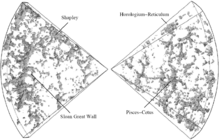Sloan Great Wall
Die Sloan Great Wall ist eine gigantische Wand aus Galaxien und stellt nach der Hercules–Corona Borealis Great Wall und dem ausgedehnten Quasar-Cluster U1.27 die größte bekannte zusammenhängende Struktur im Universum dar. Sie wurde mittels der Daten des Sloan Digital Sky Survey im Jahr 2003 entdeckt.[1] Die Struktur ist fast dreimal so groß wie die CfA2 Great Wall und hat eine Länge von rund 1,37 Mrd. Lichtjahren.[2] Sie ist rund eine Milliarde Lichtjahre von der Erde entfernt.

Grafische Darstellung des näheren Universums wie im Jahr 2007 durch die 2dF Galaxy Redshift Survey erfasst. Mitte links die Sloan Great Wall
Die Sloan Great Wall ist eine nicht gravitativ gebundene Anordnung von Galaxien
Literatur
- Maret Einasto u. a.: The Sloan great wall. Rich clusters. In: Astronomy and Astrophysics. Band 522, November 2010, S. A92, doi:10.1051/0004-6361/201015165.
Weblinks
- Astronomy Picture of the Day – Die Sloan Great Wall vom 7. November 2007 (abgerufen am 1. April 2011)
Einzelnachweise
- J. Richard Gott III u. a.: A Map of the Universe. In: The Astrophysical Journal. Band 624, Nr. 2, 10. Mai 2005, S. 463, doi:10.1086/428890.
- Kenneth R. Lang: A Companion to Astronomy and Astrophysics. Chronology and Glossary with Data Tables. Springer, 2006, S. 103
This article is issued from Wikipedia. The text is licensed under Creative Commons - Attribution - Sharealike. The authors of the article are listed here. Additional terms may apply for the media files, click on images to show image meta data.